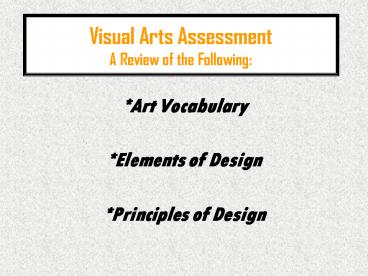Visual Arts Assessment A Review of the Following: - PowerPoint PPT Presentation
1 / 19
Title:
Visual Arts Assessment A Review of the Following:
Description:
Visual Arts Assessment. A Review of the Following: *Art Vocabulary *Elements of Design ... the artist can use elements of art to move your eye across the page... – PowerPoint PPT presentation
Number of Views:261
Avg rating:3.0/5.0
Title: Visual Arts Assessment A Review of the Following:
1
Visual Arts Assessment A Review of the Following
- Art Vocabulary
- Elements of Design
- Principles of Design
2
Art Vocabulary
- Collage- an artwork made by pasting pieces of
paper or other materials to a flat surface - Design- the way elements are put together in a
work.also called composition - Original- artwork that looks different from other
artwork not copied - Portrait- painting or drawing of a person
- Subject Matter- the subject focused on in a work
of art
3
Elements of Design
- The elements of design are things that an artist
uses to make up a work of artyou need to know
these in order to break an artwork down and
analyze it. - They are
- line, shape, color, form, texture, space, and
value - Lets examine each element
4
- This drawing is made up of lines curved ones,
straight ones, broken ones, dark ones, light
ones, etc. - Line is the dominant element in this artwork
Types of lines Diagonal, vertical,
horizontal Qualities of lines Jagged, curved,
straight, dotted, thick, thin, broken, dark, light
5
- Shape- made by closing an area with a line..
Shape - Not a Shape
Geometric shape- square, circle, triangle, etc.
Shapes can be organic or geometric.this artist
used both types of shapes.
Organic shape- natural shapes
6
- Color- many artists use color to make their work
stand out. - Knowing how to mix colors is essentialand using
the color wheel helps us to learn to mix them
Primary colors- red, blue, yellowthe first
colors Secondary colors- orange, green,
violet.mix these by combining the
primaries. Intermediate colors- red-violet,
blue-violet, red-orange, yellow-orange,
blue-green, yellow-green.these are made by
mixing the primary and secondary colors together.
7
- Form- any type of artwork that has three
dimensions (3-D) has form
and Sculpture
Like Architecture
8
- Texture- it is the way something feels or looks
like it feels artists can create the illusion
of texture (called visual texture) or they can
actually create physical texture (called actual
texture)
ACTUAL TEXTURE
VISUAL TEXTURE
9
- Space- the area that an artist creates in an
artwork the artist places things in a way to use
space wisely.like using positive or negative
space to make the work interesting
POSITIVE SPACETHE SPACE TAKEN UP BY THE OBJECT
LOOK AT THIS NEGATIVE SPACE BEING USED AROUND THE
POSITIVE SPACE
10
- Space can also be used to make an artwork look as
if it has depth. The following are ways to
create depth in a picture - Placement
- -objects are placed higher on the page to
- make them appear further
- Linear perspective
- - objects are drawn which seem to disappear
- toward a vanishing point
Overlapping -placing one object in front of
another to make one appear closer
11
- Value- the lightness or darkness of a color
LIGHT VALUES OF BLUE
DARK VALUES OF BLUE
12
- PRINCIPLES OF DESIGN
- The principles of design are basically how we use
the elements of design.in other words, the
rules/principles that artists use to organize the
elements (line, shape, color, form, texture,
space, and value) to make an artwork look good. - The principles of design are
- Center of Interest, Contrast, Repetition, Rhythm,
Balance, Movement, and Variety
13
CENTER OF INTEREST- the focal point in an
artwork What catches your attention first in a
work.
The girl is the center of interest
..she is surrounded by a lot of empty space, so
that your eyes are drawn to her.this is a
technique that artists use when they want you to
focus on a main area in an artwork
14
- Contrast- when you use things in a work that are
very different from eachother.like dark/light
Notice the dark colors in the foreground and the
light in the background
Artists use contrast to catch attention.often to
make a work seem dramatic
15
- Repetition- repeating shapes, lines, objects in a
work to make it interesting
This artist used repeating stars to surround the
center of interest. It adds interest to the work.
16
- Rhythm- just like music, artists also use
rhythm.artists can use rhythm to make your eye
flow across the page.
This artist repeated objects over and over to
create a rhythm to lead your eye across the work
17
- Balance- artworks need balance so that the
subject matter doesnt seem too heavy on one side
This work is balanced with symmetry (same on each
side)
This work is balanced using asymmetry.it is not
the same on each side, but is still balanced.
18
Movement- the artist can use elements of art to
move your eye across the page.they can determine
where they want your eyes to go.
In this painting, the artist moves your eyes from
the front of the work with the place settings
toward the back of the work to the girl in the
chair.
19
- Variety- artists dont want their paintings to
be boring, so they often use a variety of sizes,
shapes, colors, etc. to make their works
interesting.
Notice the variety of shapes (large, small,
square, circular) and lines in this work.































